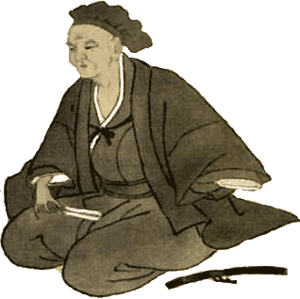Murata Jukō facts for kids
Quick facts for kids
Murata Jukō
|
|
|---|---|
| 村田珠光 | |

Murata Jukō
|
|
| Born | 1423 |
| Died | 1502 (aged 78–79) |
| Nationality | Japanese |
| Other names | Murata Shukō |
| Known for | developing the Japanese tea ceremony |
|
Notable work
|
Letter of the Heart |
Murata Jukō (村田珠光, 1423–1502) was a very important person in Japanese history. He is known as the founder of the Japanese tea ceremony. He created a special style of tea ceremony called wabi-cha. This style used Japanese tools and had a simple, quiet feeling. His name can also be said as Murata Shukō.
Contents
Murata Jukō's Life
Murata Jukō was born in Nara, Japan. Some people say his father played the biwa, a Japanese string instrument. But most believe Jukō came from a family of merchants.
When he was young, Jukō worked at a Buddhist temple in Nara. He saw noisy tea parties called tocha. These parties were not for him. Instead, he became interested in tea because it helped him stay awake while studying.
His interest in tea led him to Kyoto. There, he learned about the fancy tea ceremonies of the rich from a master named Nōami. Jukō also studied Zen Buddhism with a priest called Ikkyū Sōjun. Ikkyū taught him that "the Buddha dharma is also in the Way of Tea." This idea inspired Jukō to create his own tea ceremony style. Ikkyū even gave Jukō a special piece of writing as a sign of his deep understanding.
Jukō's Tea Philosophy
Jukō wrote down his main ideas about the tea ceremony in a letter. He sent it to his student Furuichi Chōin around 1488. This letter is now known as the Kokoro no fumi (心の手文, "Letter of the heart"). It was kept safe by a family for many years. Later, another famous tea master, Sen no Rikyū, praised it highly.
Blending Styles
The Kokoro no fumi helped Japan's merchant class become important in the world of tea. Jukō believed in using both Japanese and Chinese tea items. He especially liked simple, unglazed Japanese pottery from places like Bizen and Shigaraki.
However, he still used the beautiful Chinese pottery that was popular before him. His letter even said to "harmonize Japanese and Chinese tastes." Jukō thought it was wrong to care too much about the flaws of Japanese items. He also thought it was wrong to only like the perfect Chinese ones. He suggested that beginners should start with Chinese pieces. This would help them truly appreciate Japanese items later.
Four Key Values
Jukō taught four important values for the tea ceremony:
- kin: This means being humble and respectful.
- kei: This is about respecting the food and drink.
- sei: This means having a pure body and spirit.
- jaku: This is a Buddhist idea about being calm and free from wanting things.
Designing the Teahouse
Jukō also helped create the yojohan (four-and-a-half mat teahouse). This design later became the standard for tea ceremonies. He changed the tokonoma, which is a special alcove in the room. He made the teahouse a more spiritual place for the ceremony.
He wanted to bring ideas from renga poetry into the tea ceremony. Renga is a type of Japanese linked verse. Jukō was very good at writing renga. He used ideas like hie (chill) and kare (withered). He felt these qualities were shown in the Japanese bowls and jars he used.
Later, Takeno Jōō studied with Jukō's students. Jōō continued to make the tea ceremony simpler. Jōō was also the teacher of Sen no Rikyū, who became one of the most famous tea masters.

